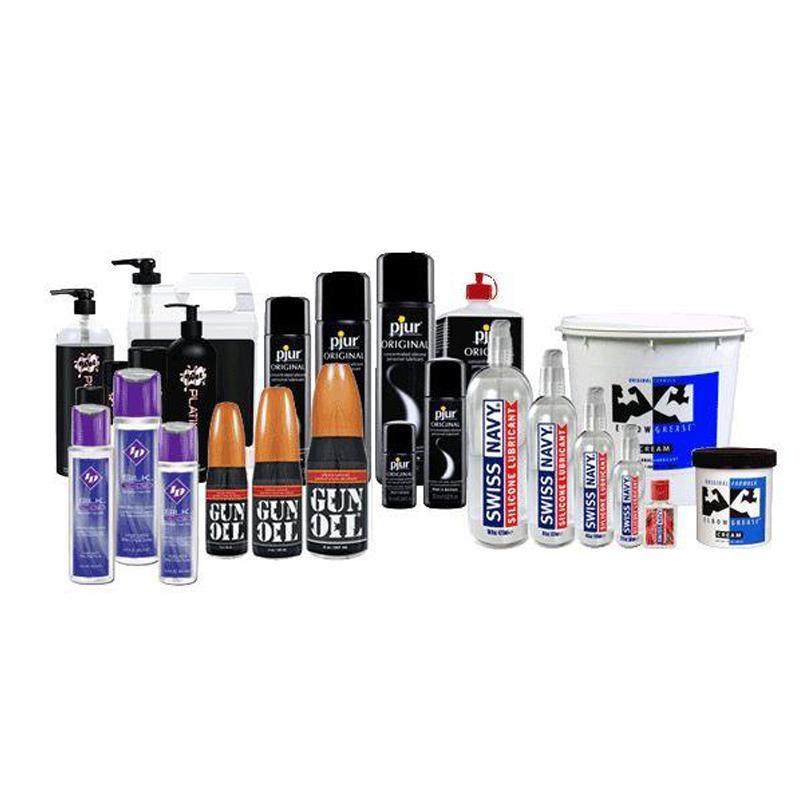
Types of Personal Lubricant
Chase M1 comment
For anyone who has ever been confused about the many types and brands of lubricants out there, we can break it down into four basic categories. Each of these categories can have subcategories, which we will discuss in a later blog. But for now, we will keep it simple. The four basic categories are based on the underlying chemistry of the product. They are Water-Based, Silicone-Based, Oil-Based, and Hybrid. Each of these lube types have pros and cons, so choosing the right lube for the right job is essential. Let's take a quick look at each type individually. 
1. Water-Based
This is the most prevalent of all lubes. The senior lubes such as KY and Astroglide, ID Glide, and Wet Original are examples of this type of lube. As the name indicates, water-based lubricants are composed of mostly water and generally some kind of glycerin. They can be a bit sticky, and the water tends to evaporate quickly, especially in warm weather, so make sure you have some extra lube handy or a spritzer bottle of water to reactivate the lube. It washes away easily with soap and water and generally will not stain your expensive sheets.
Pros:
- Cheap
- Easy to Find
- Easy Clean-Up
- Won't Stain Sheets
- Condom Safe
Cons:
- Sticky
- Short Lifespan
- May Contain Parabens or Glycerin

2. Silicone-Based
Silicone-Based Lubricants have come into popularity in the last 15 years or so more so in the gay community than the straight community; however, they are becoming more popular all the time.
Silicone-based lubricant's primary ingredient is a combination of Cyclopentasiloxane, Dimethicone, and/or Dimethiconol. These are silicone polymers compounds that are used in cosmetics and personal care products as a skin and hair-conditioning and moisturizing agent. This sounds all complicated, and it is unless you are a chemical engineer. In short, they are slippery as can be and long-lasting alternative to water-based.
They are excellent if you want to have sex in the shower as they are water-resistant. However, that can also be troublesome as they are hard to clean up off hard surfaces and do not wash away easily after sex. The one thing you do NOT want to do is jump from sex into the shower to try and clean the Silicone off your body. Water will just bead up on your skin and it will take a lot of soap and warm water to get the residue off. This will also make the shower extremely slippery so watch your step. (Tip: After sex, wipe away excess lube on skin with clean dry paper towel and cuddle for 15 minutes. This can help your interpersonal relationship and allow for the silicone lube to absorb into your skin as a moisturizer making your skin feel soft and making showering remarkably easier.)
Silicone lube should not be used with expensive Silicone Toys. Silicone breaks down Silicone. Silicone cockrings tend to break faster when used with Silicone, and the skin of Silicone toys will start to feel sticky or grainy after a few uses if not adequately maintained.
Last but not least, I don't care what any manufacture says, if you forget to put the cap on in the heat of the moment and half the bottle spills out on your expensive sheets it is going to be there the rest of your life. Small amounts can be washed away but if it's a big spill you might have to learn to live with it.
Pros:
- Very Slippery
- Long-Lasting
- Great for Sex in Water
Cons:
- Hard to Clean Up
- May Stain Sheets
- Can Break Down Expensive Silicone Toys

3. Oil Based
DO NOT USE OIL-BASED LUBRICANTS WITH LATEX CONDOMS
Oil-based lubricants are petroleum-based products and are the oldest type of lubricants out there. Stroke 29, Boy Butter, Elbow Grease are all brands of oil-based lubricants. Oils such as Baby oil, lotion, and Vaseline are also types of oil-based lubricants but we would not recommend using these for personal lubricants.
Oil-based lubricants can be much slicker than other types of lubricants and will help soften the skin. However, they will break down latex quickly, thus making latex condoms prone to breakage and ineffective. With the creation of polyurethane condoms which are not destroyed by oil-based lubricant, oil-based lubricants have recently become more popular. They generally are primarily used for masturbation purposes in products such as Stroke 29.
Pros:
- Good For Masturbation
- Long-Lasting
Cons:
- NOT Latex Condom Safe
- Can Irritate Sensitive Skin
- Can Stain Sheets

4. Hybrid Lubricant
(Water + Silicone) — Hybrid personal lubricants are the newest type of lubricants developed. These lubricants generally are water-based lubricants with a small amount of Silicone added to extend slipperiness. These lubes are often white or cloudy in appearance due to the combination of Water and Silicone so they can easily be identified in bottles.
Lube, such as Liquid Silk, is considered a hybrid lubricant. So are the many Fetish based "Cum" lubes on the market. The White or cloudy appearance resembles seaman, which for some fetish prone individuals, is an exciting addition to their sex life.
Pros:
- Last Longer Than Water-Based
- Easier to Clean Up Than Silicone-Based
Cons:
- May Become Sticky
- Could Degrade Some Silicone Toys



Comments (1)
“The White or cloudy appearance resembles seaman….an exciting addition to their sex life.”
I’ e always liked a handsome sailor, but I think you want to write “semen!”